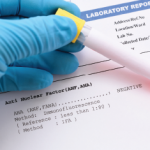“The rationale for ordering ANA [testing] is often to guide initial diagnosis and management. We thought, ‘Let’s take a look and see if there are any differences in how these patients are presenting at clinic,’” Dr. Paknikar says.
Younger, Female, Non-Smoking
Within about 90 days of fulfillment of RA criteria, 161 (64%) of the 252 patients with RA in the study cohort were tested for ANA, and 25% were positive. The patients who were ANA positive tended to be women (20% vs. 37%; P=0.04); slightly younger, or a mean age of 51 years old vs. a mean of 55 years old (P=0.08); and less likely to currently smoke (5% vs. 17%; P=0.10). There were no differences in ANA positivity between patients who were seropositive or seronegative for RF or anti-CCP antibodies.
Patients who were seropositive for RF and ANA positive took a longer time to fulfill RA criteria, or a median of 16 days from their first joint swelling to fulfillment of the 1987 ACR Classification Criteria for RA, as opposed to a median of zero days for ANA-negative patients. ANA-positive patients also took a median of three days from their first sign of joint swelling to fulfill the 2010 ACR criteria, compared with zero days for ANA-negative patients.
Patients in both groups met the criteria in similar ways. Both groups had morning stiffness, rheumatoid nodules, joint erosions, and abnormal C-reactive protein (CRP) and erythrocyte sedimentation rate (ESR) levels.
In the study, patients with ANA-positive RA also had a longer wait time before being offered treatment with a disease-modifying anti-rheumatic drug (DMARD), or a median of 41 days vs. 13 days (P=0.20). They were more likely to be treated with hydroxychloroquine as their first-line RA therapy than methotrexate (44% vs. 23%; P=0.03). Patients who were anti-CCP-antibody positive and ANA positive waited significantly longer to initiate DMARD therapy than those who were anti-CCP positive and ANA negative: 50 days instead of 10 (P=0.043). At five years, researchers did not find other differences, including differences in disease activity and mortality, between patients who were ANA positive and those who were ANA negative.
DMARD Choices Still Unclear
Although this new study’s results show some interesting differences between patients with ANA-positive and ANA-negative RA, it also raises questions about why these differences exist, says Dr. Paknikar.
“We have established how and when patients met the RA criteria, but not differences as far as their disease burden. There was increased time to the patients being offered their first DMARD, and they were more likely to be offered hydroxychloroquine, not methotrexate. Is that because of their ANA positivity? Or [was it due to] something we haven’t identified yet?” she says.
